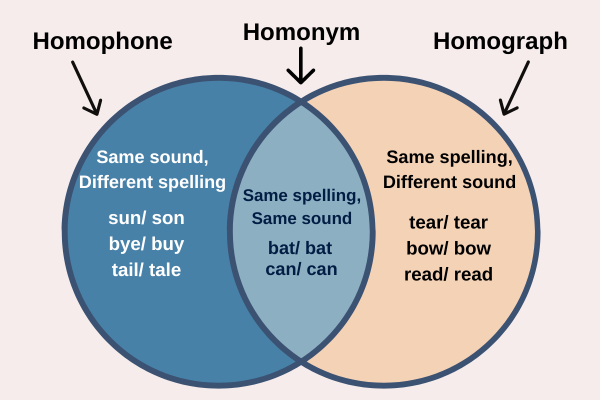Embarking on a new language adventure can sometimes feel like finding your way through a maze, especially when words sound alike but mean different things.
French, with its beautiful words and tricky grammar, adds an extra layer of challenge.
Homophones, those tricky words that sound the same but mean different things, often bring a mix of confusion and humour for both native speakers and learners.
But fret not! This guide is your trusty companion, guiding you through the twists and turns of homophones in French and making your language journey a tad bit easier. 🗺️✨
Difference Between Homophones and Homonyms
Imagine you have two buddies: Homophones and Homonyms. They’re a bit like twins, but with different personalities.


Homophones are words that sound the same but might have different meanings and spellings. It’s like “flower” and “flour” – they sound alike but mean totally different things.
Now, meet Homonyms. They’re the true twins, sharing the same name and often the same spelling, but they might have different meanings. Think of “bat” – it could be something you play baseball with or a creature that flies around at night.
So, Homophones sound alike, Homonyms look alike. It’s a wordy family reunion, and you’re the guest of honour! 🎉📚
Identifying the French Homophones
Dealing with French homophones might make you want to pull your hair out, but guess what?
They’re like the spice that adds flavour to the French language! Learning to tell them apart needs some detective skills—paying attention to context, how things are pronounced, and their spelling.
French pros, the native speakers, usually use context to figure out which homophone is which.
For us language learners, it’s like cracking a secret code. So, keep your detective hat on, and let’s unravel the mystery of these tricky words! 🕵️♂️
Meet the French Homophones
Some of the examples of french homophones:
1. a vs. à
| Word | Meaning | Example | Translation |
|---|---|---|---|
| a | Third-person singular of “avoir” (to have) | Il a faim. | He’s hungry. |
| à | Preposition indicating location or direction | Je vais à Lyon. | I am going to Lyon. |
2. et vs. est
| Word | Meaning | Example | Translation |
|---|---|---|---|
| et | Conjunction meaning “and” | J’achète des vêtements et des chaussures. | I buy clothes and shoes. |
| est | Third-person singular of “être” (to be) | La salle est propre. | The room is clean. |
3. son vs. sont
| Word | Meaning | Example | Translation |
|---|---|---|---|
| son | Possessive adjective (“his” or “her”) | C’est son pantalon. | It’s his/her pants. |
| sont | Third-person plural of “être” (to be) | Elles sont bourrées. | They are drunk. |
4. ou vs. où
| Word | Meaning | Example | Translation |
|---|---|---|---|
| ou | Conjunction meaning “or” | Veux-tu du café ou du thé ? | Do you want coffee or tea? |
| où | Adverb meaning “where” | Où est la gare ? | Where is the train station? |
5. ces vs. ses vs. s’est
These homophones often cause confusion!
Ces livres sont les siens, pas les miens, et elle s’est trompée. (These books are hers, not mine, and she made a mistake.)
6. paie vs. paix vs. pet
| Word | Meaning | Example | Translation |
|---|---|---|---|
| la paie | Pay/salary | Il attend avec impatience sa paie. | He eagerly awaits his pay. |
| la paix | Peace | Ils veulent la paix dans la région. | They want peace in the region. |
| le pet | Fart | Un petit pet a provoqué des rires. | A little fart caused laughter. |
7. pair vs. paire vs. père
| Word | Meaning | Example | Translation |
|---|---|---|---|
| pair | Even (number) | Le nombre 4 est pair. | The number 4 is even. |
| un pair | Peer | Il est respecté par ses pairs. | He is respected by his peers. |
| la paire | Pair (of something) | J’ai une nouvelle paire de chaussures. | I have a new pair of shoes. |
| le père | Father | C’est ton père. | It’s your father. |
You can find a list of French homophones here.
Common Examples of French Homophones
Vers:
- Vers (worm): Tiny creatures in the soil.
- Vers (towards): Moving in the direction of.
Fait:
- Fait (fact): Something that is true or an event.
- Fait (did): Past tense of the verb “to do.”
Cours:
- Cours (running): The act of moving swiftly on foot.
- Cours (classes): Regularly scheduled educational sessions.
Police:
- Police (police): Law enforcement officers.
- Police (font): A style or size of type in printing.
Tips for Understanding the French Homophones
1. Context is Your Friend
Pay attention to the context in which the word is used. It often gives clues about the correct meaning.
- How to use it: Pay close attention to the words surrounding the homophone. The context will provide clues about the correct meaning.
- For example, in the sentence “Il a une idée,” (He has an idea), the context of possession indicates the use of ‘a’ instead of ‘à.’
2. Practice, Practice, Practice
The more you use these words in context, the easier it becomes to distinguish them.
- How to use it: Create your own sentences using difficult french homophones. The more you use them in context, the easier it becomes to remember the distinctions.
- Practice writing and speaking sentences to build familiarity and confidence.
3. Buddy System
Pair up similar-sounding words in your mind. Create mental associations to remember their differences.
- How to use it: Pair up the most common french homophones that sound alike in your mind. Create mnemonic devices or visual images to link the words and their meanings.
- For example, associate ‘a’ with possession by thinking of someone holding an idea (‘a’) and ‘à’ with direction by visualising an arrow pointing somewhere (‘à’).
4. Listen and Repeat
Developing an ear for the language enhances your ability to recognize subtle pronunciation differences.
- How to use it: Listen to native speakers, whether through podcasts, videos, or conversations. Pay attention to how they pronounce and use homophones. Mimic their pronunciation to improve your own ability to distinguish between similar-sounding words.
5. Keep a French Homophones Cheat Sheet
Having a reference guide handy can be a quick way to refresh your memory.
- How to use it: Create a cheat sheet or flashcards with examples of each homophone pair. Keep it easily accessible for quick reference when you come across a challenging word.
- Review the cheat sheet regularly to reinforce your understanding.
6. Seek Feedback
Getting feedback from native speakers or language teachers can provide valuable insights.
- How to use it: Share your sentences or paragraphs containing homophones with native speakers or language learners.
- Ask for feedback on whether you’ve used the correct homophone in each instance. Constructive feedback helps reinforce correct usage.
Common Mistakes When Using French Homophones
Common pitfalls with homophones in French often arise due to their similar pronunciation but distinct meanings. Here are some common mistakes and tips to avoid them:
1. Misuse of “a” and “à”
- Pitfall: Confusing “a” (third person singular of the verb “avoir”) with “à” (preposition meaning ‘to’ or ‘at’).
- Tip: Remember that “a” denotes possession, while “à” indicates direction or location.
- Example: “Il a une voiture” (He has a car) versus “Il va à l’école” (He goes to school).
2. Mixing up “et” and “est”
- Pitfall: Interchanging “et” (conjunction meaning ‘and’) with “est” (third person singular of the verb “être” meaning ‘is’).
- Tip: Double-check whether you are connecting items with “et” or describing a state of being with “est.
- Example: “Le chat est noir et blanc” (The cat is black and white) versus “Il est heureux” (He is happy).
3. Confusing “son” and “sont”
- Pitfall: Misusing “son” (possessive adjective) instead of “sont” (third person plural of “être”).
- Tip: Pay attention to the context; “son” refers to possession, while “sont” indicates a plural form of “être” (to be).
Example: “Ses enfants sont à l’école” (His/Her children are at school) versus “Son livre est intéressant” (His/Her book is interesting).
4. Interchanging “ce” and “se”
- Pitfall: Using “ce” (demonstrative pronoun) instead of “se” (reflexive pronoun) or vice versa.
- Tip: “Ce” is used to indicate a specific thing, while “se” is a reflexive pronoun used with verbs.
- Example: “Il se lave les mains avec ce savon” (He washes his hands with this soap).
5. Misusing “ce” and “se” with “s’est”
- Pitfall: Confusing “ce” and “se” with the reflexive form “s’est” of the verb “être.”
- Tip: “S’est” is a reflexive form, meaning ‘himself,’ ‘herself,’ or ‘itself.’
Example: “Ce livre est intéressant” (This book is interesting) versus “Il s’est levé tôt” (He got up early).
Why Do the French Have So Many Homophones?
Let’s unravel the mystery of why French is like a homophone party!
Time Travel Through Language History:
Long ago, French was like a time traveller, starting as a cool Romance language from Latin. In Latin, words changed their sounds based on grammar rules. As time strolled along, those sounds twisted and turned, creating French homophones.
Example: “ille” (he/she) in Latin turned into “il” (he) in French.
Borrowed words:
French loves to borrow words from different languages, including Latin, Greek, English, and Arabic. When it borrows, it sometimes ends up with words that sound the same but have different meanings—French homophones!
Example: “pain” (bread) originates from Latin. But in Old French, bread is called “panis.”
Liaison:
Imagine you’re saying a word in French, and it ends with a quiet, shy consonant.
But guess what? If the next word starts with a vowel, that shy consonant might decide to speak up and join the party!🎉
For example, let’s consider that you’re talking about a beautiful garden in French, and you say “un grand arbre” (a big tree).
Usually, the “d” in “grand” and the “a” in “arbre” would be silent on their own. But, when they team up, that “d” decides to make its presence known, and suddenly, it sounds like “un gran tarbre.”
So, in the world of French homophones liaison, silent letters occasionally come to life, creating a smoother and more connected flow in French pronunciation!🗣️
Evolutionary Changes and Silent Letters:
French is a bit like a superhero, always changing and evolving.
In the old days, there was a word “san” meaning blood and another “sans” meaning without. Today, they both sound like “san.” It’s like they decided to join forces and share the same vibe.
Similarly, the Old French word “estre” (to be) merged with the word “est” (is), both pronounced as “est”.
Pronunciation Hints:
Some french homophones are like secret agents with distinct accents.
Take “fait” for instance, meaning both “fact” and “did.”
They sound the same, but one has an open “a” sound, and the other has a closed “a” sound. It’s like their pronunciation fingerprints reveal their true identities.
Spelling Clues:
Imagine french homophones as spelling puzzle pieces. They might sound alike, but their spellings drop little hints.
Like “la” (the) and “là” (there).
They sound similar, but the accent aigu (é) in “là” gives it away. It’s like a spelling adventure where accents become the heroes.
Ever Noticed How Some Words in English and French Are the Same?
They look and sound the same in both languages.
For example:
- Table – it’s where you eat and chat.
- Fiancé or Fiancée – the person you’re happily engaged to.
- Élite – that fancy word for a super special group
- Chef – pro cook
- Débris – The remains or ruins of something destroyed.
These words connect us across languages, making conversations a blend of both French and English vibes.🌐
Embracing the Homophone Phenomenon
Homophones bring a uniqueness to languages, and guess what? Every language has its set of these playful word twins, also known as homophones!
Instead of seeing them as tricky hurdles, think of homophones as friendly companions on your language journey. They add a dash of fun and surprise to conversations. Embrace them by playing with words, practising in sentences, and turning them into your language buddies.
So, whether it’s English, French, Korean or any other language, homophones are like the cool quirks that make languages unique and interesting.
Ready to make friends with these language doppelgängers? 🌐🤝





